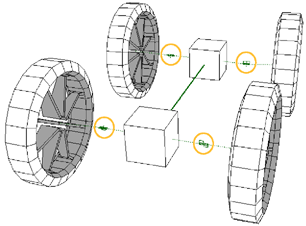The hinge, ball-and-socket, and slider constraint types include motors. Motors make the constraint move without any other means of animation. Using motors is a cool way of animating rigid bodies, such as a walking robot, a crawling insect, or a car.

Each of the four hinge constraints on this "car" have motors activated to make the wheels rotate and move forward.
A motor applies a torque (force) to a constraint to get it to move at a desired speed (velocity). The motor only works with two rigid bodies used in the constraint relationship, and both rigid bodies must be active.
Select a hinge, ball-and-socket, or slider constraint.
Make sure that the two rigid bodies that are attached to this constraint are both active.
In the constraint's property editor, click the Motor tab and activate the Motor option.
Then set these parameters:
Motor Velocity is the maximum amount of velocity that the motor can generate.
If you're using structures that have mirror symmetry, like legs walking, use negative velocity values on one of the sides to make the motor go in the opposite direction.
Maximum Torque is the maximum amount of force that can be applied to the constrained object.
Remember that the higher the mass of the attached rigid bodies, the higher the velocity and torque values to move them.
If you're using a ball-and-socket constraint, the Motor Axes - X/Y/Z Component are the axes on which the ball-and-socket constraint applies the motor on the rigid bodies. The values you can use for the motor are from -1 to 1. A value of 0 means that the axis is not used.
 Except where otherwise noted, this work is licensed under a Creative Commons Attribution-NonCommercial-ShareAlike 3.0 Unported License
Except where otherwise noted, this work is licensed under a Creative Commons Attribution-NonCommercial-ShareAlike 3.0 Unported License